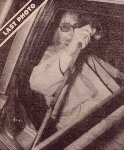
GARBO THE GREAT DIES
Mystery ailment
claims screen
legend at 84
By LEO STANDORA
|
| |
TAYLOR:
”Camille,” with Robert Taylor, was
hailed as
a triumph for Garbo.
|
GABLE:
She and the young Clark Gable
smoldered
in 1931's
“Her Fall and Rise.”
|
|
|
MARCH:
Frederic March and Garbo made
“Anna Karenina”
one of her greatest movies.
|
VON STROHEIM:
A steamy epic, “As You Desire Me,”
with Erich von Stroheim.
|
|
|
SULTRY SWEDE:
Garbo's first talking picture,
the 1930 flick“Anna Christie,”
revealed her throaty, sensual
voice.
|
Greta Garbo, whose name still meant star nearly half a century after she made her last movie, died here yesterday at New York Hospital.
The Swedish-born actress – who became a living legend – was 84.
The hospital declined to immediately disclose the cause of death.
Garbo spent seven hours at the hospital last Wednesday, but was sent home.
She had been undergoing treatment since last year, but her ailment – like the rest of her life – was kept secret.
A neighbour in Garbo's East Side apartment building said the actress had been undergoing kidney-dialysis treatments, but that couldn't immediately be confirmed.
Garbo, whose passion for privacy was as well-known as her perfectly chiselled features and husky voice, retired from the silver screen in 1941 after making her last film, “Two Faced Woman.”
But her shining performances in 24 films – 10 of them silent – made her a favourite of younger generations who saw in her an ethereal ideal of the ultimate woman.
Her electrifying presence in such silent films as “Flesh and the Devil,” “Love,” and “The Kiss,” alerted audiences to the arrival of an extraordinary leading lady who reigned as Hollywood's supreme movie queen through-out the 1920s and ‘30s.
Garbo was born in Stockholm on Sept. 18, 1905, to poor parents and as a young girl left school to work as an assistant in a barbershop and salesgirl in a department store.
But a film commercial for the department sore and later a bit part in a movie as a bathing beauty put Garbo on the road to the Royal Dramatic Theatre School – and Hollywood.
By some standards, Garbo was less than glamorous.
She had a lithe but rather androgynous body, thick legs and a mannish walk.
Still, public response to the sight of her perfectly sculpted features and her figure outlined in silky halter gowns sometimes was so frenzied that the phenomenon became known as “Garbomania.”
Talking pictures revealed her throaty, sensual voice and further enhanced her appeal.
She became an international sensation, drawing rave reviews in “Anna Christie,” “Mata Hari,” “Grand Hotel,” “Queen Christina,” “Camille,” “Ninotchka” and other films.
But the hysteria was anathema to the woman who was internationally known simply as “Garbo” one of the world's most fascinating recluses.
Although remembered most for her reputed pronouncement to reporters: “I vant to be alone,” the film star denied ever having said the line. Instead, she told a friend that what she had said was, “I want to be left alone.”
While “Camille,” and “Ninotchka” were enshrined at repeated film festivals and worshipped by devoted Garbo fans, the star remained shuttered in her apartment or retreats in France and Switzerland.
Although nominated four times for Academy Awards, she didn't win one until 1955 when the academy presented her with a special Oscar for “a series of luminous and unforgettable performances.”
Then she didn't appear to collect it.
Rumors of her love affairs with rich and famous men were plentiful but she never married and in her later years allowed only a few long-time friends to penetrate the fortress of her solitude.
Few would discuss the star, knowing they would lose her friendship if they did.
Garbo remained an enigma to the end.
“There are many things in your heart you can never tell to another person,” she said. in one of her last interviews.
“They are you, your private joys and sorrows, and you can never tell them. You cheapen yourself, the inside of yourself, when you tell them.”
|
| Films of a legend
Here is a list of Greta Garbo's 24 MGM films and three made before arriving in the United States:
1. “Peter the Tramp,” 1922.
2. “The Atonement of Gosta Berling,”
1924.
3. “Joyless Street,” 1925.
4. “The Torrent,” 1926.
5. “The Temptress,” 1926.
6. “Flesh and the Devil,” 1927.
7. “Love,” 1927.
8. “The Mysterious Lady,” 1927.
9. “The Divine Woman,” 1928.
10. “The Kiss,” 1929.
11. “A Woman of Affairs,” 1929.
12. “Wild Orchids,” 1929.
13. “The Single Standard,” 1929.
14. “Anna Christie,” 1930.
15. “Romance,” 1930.
16. “Inspiration,” 1931.
17. “Susan Lennox, Her Rise and
Fall,” 1931.
18. “Mata Hari,” 1931.
19. “Grand Hotel,” 1932.
20. “As You Desire Me,” 1932.
21. “Queen Christina,” 1933.
22. “The Painted Veil,” 1934.
23. “Anna Karenina,” 1935.
24. “Camille,” 1936.
25. “Conquest,” 1937.
26. “Ninotchka,” 1939.
27. “Two-Faced Woman,” 1941.
|
FINAL DAYS:
In this exclusive Post photo, the legendary Garbo arrives at New York Hospital last Wednesday, and left after seven hours.
|

EXCLUSIVE Albert Ferreira/DMI |
|
BARRYMORE:
With John Barrymore in the 1932
Oscar-winner “Grand Hotel.”
|
GILBERT:
John Gilbert, her co-star in “Queen Christina,” was also her lover in real life.
|
|
|
NAVARRO:
She bewitched audiences,
and Ramon
Navarro, as
femme fatale “Mata Hari.”
|
BOYER:
She teamed with great screen sex
symbol Charles Boyer in “Conquest.”
|
|
from: New York Post, 1990, April 16
© Copyright by New York Post
|